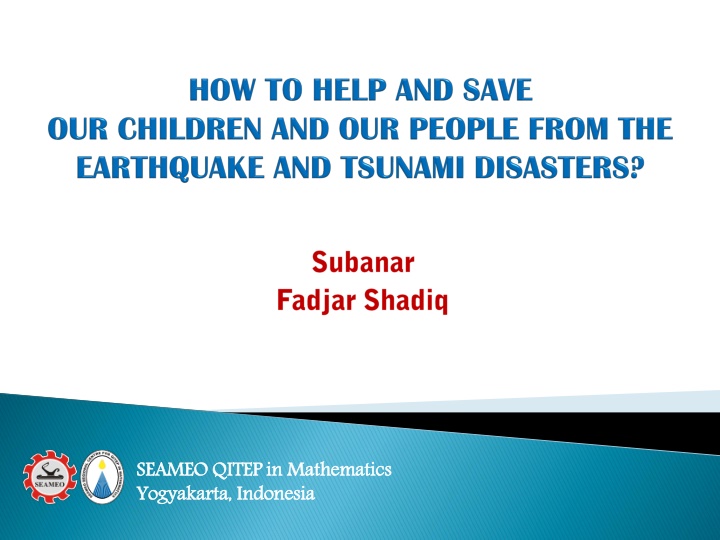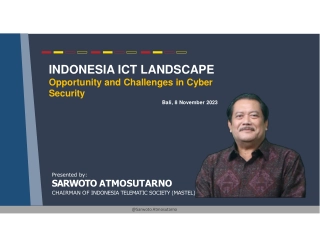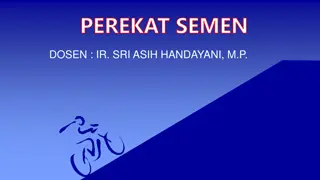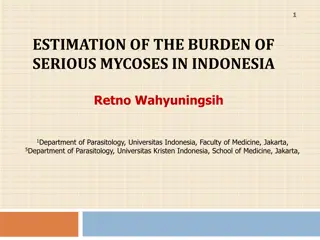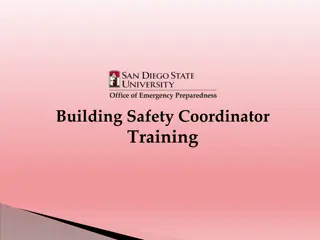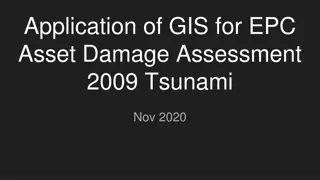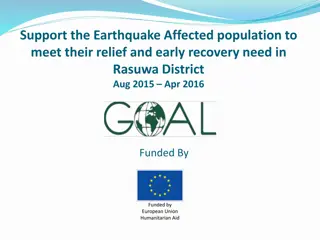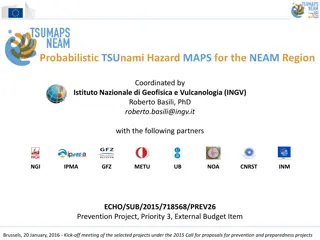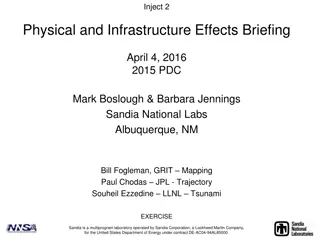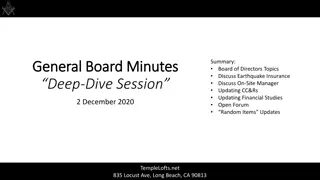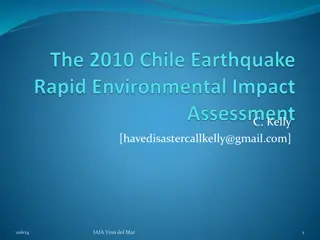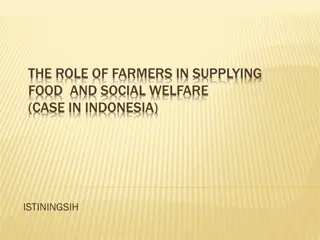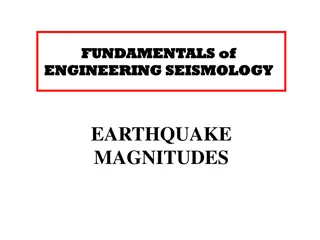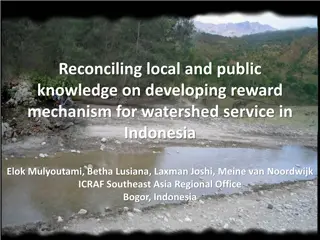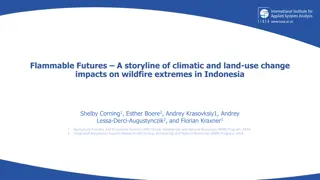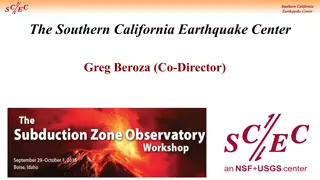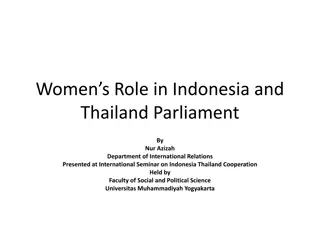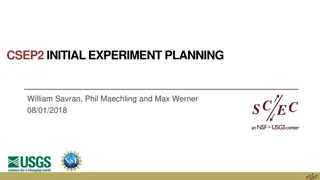Impact of 2004 Earthquake and Tsunami in Indonesia
Devastating earthquake and tsunami in 2004 wreaked havoc in Indonesia, resulting in massive casualties and economic losses across various sectors. The total impact of the disaster illustrates the profound challenges faced by the country in recovery and reconstruction.
Download Presentation

Please find below an Image/Link to download the presentation.
The content on the website is provided AS IS for your information and personal use only. It may not be sold, licensed, or shared on other websites without obtaining consent from the author.If you encounter any issues during the download, it is possible that the publisher has removed the file from their server.
You are allowed to download the files provided on this website for personal or commercial use, subject to the condition that they are used lawfully. All files are the property of their respective owners.
The content on the website is provided AS IS for your information and personal use only. It may not be sold, licensed, or shared on other websites without obtaining consent from the author.
E N D
Presentation Transcript
SEAMEO QITEP in Mathematics Yogyakarta, Indonesia SEAMEO QITEP in Mathematics Yogyakarta, Indonesia
On 26 December 2004, in Banda Aceh, an earthquake struck 150 km off the coast of Aceh. Forty five minutes later, the first tsunami waves struck and caused thousands of kilometers of coastline in Aceh and North Sumatra Provinces and the western islands. There were 164,891 people buried, 114,897 people missing and 412,438 people displaced. Tsunami in Aceh.wmv Table 1.docx massive damage to
Total impact of Damage and Losses in Earthquake and Tsunami 2004 in Indonesia In addition to the death of thousands people due to the combined action of tsunami and earthquake, the analysis reveals that public and private properties in Indonesia are inevitably destructed as well. The estimated total value of the total impact is up to Rp. 41,03 Billion The damage and losses in the social sectors highest one with the percentage of 39%. They cover housing, education services, health services, and places of worship. Housing, both urban and rural, was the most affected one with estimated monetary value of Rp. 13,37 Billion. Table 1.docx social sectors are the Table 1.docx Damage and losses to infrastructure Billion (20%) and were dominated by the damage to transportation. Table 1.docx .Much of the primary transportation infrastructure of Aceh province is in the coastal areas, due to the steep inland terrain and concentration of socioeconomic activity, and was therefore at a high risk of the tsunami threats. infrastructure totalled Rp. 8,15 Table 1.docx The earthquake and tsunami had a devastating impact upon the productive sectors of the economy of 26%. Thousands of enterprises and livelihoods have been destroyed and, among those that survived the disaster, hundreds of thousands of people have been made unemployed. Thus, rebuilding the productive sector in the affected areas is one of the most important and difficult challenges facing the country. Cross-sectoral was the smallest affected sector of 15%. It covers environment, regional governance, and bank and finance. The damage and losses of this sector was estimated around Rp. 6,06 Billion. Table 1.docx
On 27 May 2006, at 5:54 local time, a medium-sized earthquake hit the central section of the Java Island. Table 2. Distribution of casualties by district (BAPPENAS, 2006) Province and District Death Toll Number Injured Yogyakarta Bantul Sleman Yogyakarta City Kulonprogo Gunung Kidul Central Java Klaten Magelang Boyolali Sukoharjo Wonogiri Porworejo Total 4,659 4,121 240 195 19,401 12,026 3,792 318 2,179 1,086 18,526 18,127 22 81 1,057 1,041 10 4 1 24 300 67 - 4 4 1 5,716 37,927 The death toll of Yogyakarta earthquake was estimated at over 5,700, while injuries were more than 37,000.
In Yogyakarta earthquake, most hit districts were Bantul in Yogyakarta Province and Klaten in Central Java Province. Bantul was the worst shaken by the earthquake, the death toll of the district was 72% of the total or approximately 4,000 people died, while more than 12,000 people in Bantul injured (31%). Additionally, in Klaten, more than 1,000 people were reported died and around 18,000 people injured.
Hazards such as floods, earthquakes, and tsunamis become disasters only when society lacks the ability to cope with them (UNESCO, 2010). In addition, when a natural hazard strikes, children are among the most vulnerable population group, especially those attending school in times of disaster. UNESCO ISDR (2007) gives two good examples that what people know is more important that what they have when it comes to saving lives and reducing loss. 1. On a beach in Thailand, when the December 2004 Tsunami struck, British schoolgirl T. Smith saved many lives by urging people to flee the shore: her geography class in Britain had enabled her to recognize the first signs of a tsunami. 2. Anto, a young boy on the Indonesian island of Simeulue had learned from his grandfather what to do when an earthquake strikes. He and all the other islanders ran to higher ground before the tsunami struck, sparing all but eight members of the community. Indonesian people must learn about those disasters threats and its impact on their lives. For saving our life, Emergency Preparedness Education is one of the most urgently needed topics for school education.
This project will develop e-textbooks on mathematics for emergency preparation through the lesson studies done by the specialists. Specifically, the aims of the development of the e-textbooks for students are as follows. 1. To increase the awareness of Indonesian students on the danger of disasters in their daily lives. 2. To help and facilitate students with the scientific and practical knowledge about disaster risks (before, during, and after the disasters) and related skills to reduce or minimize it. 3. To increase Indonesian students beliefs on the importance of mathematics, science, and technology that will motivate them having good attitudes toward mathematics, science, and technology. 4. To increase the awareness of Indonesian students to predict and anticipate the earthquakes and tsunamis.
1. In contexts to the earthquakes and tsunamis data or its presentation that require students to solve problems or model situations, students should be able to: (a) investigate questions by using the statistical enquiry, gathering, displaying, and/or identifying similarities and differences in categorical data; and (b) describe the likelihoods of outcomes for a simple situation involving chance using daily language. 2. From Table 4.1.docx (see Elnashai et.al, 2006:14), students can learn that major earthquakes larger than magnitude 7 occur every about 25 years. The mathematical concept related to this finding is about periodic functions. Figure 1.docx indicates that there were many strong events affecting Java and confirms that the tectonics of the region are dominated by the subduction of the Australia plate north- northeastward beneath the Sunda micro-plate.
3. From the Yogyakarta earthquake report (Elnashai, A.S., et all), we can learn that the contour map for horizontal and vertical ground motion have geometrical concept like ellipse and circle. The students can learn that the larger the radius, the less the affected region will be. 4. In contexts to the magnitude of earthquakes in Richter Scale in which operates on a logarithmic basis so there is a 10-fold increase from one unit to the next (Jacobs, 1982:227). He also states that an earthquake rated 4 on the Richter scale has been assigned a relative intensity of 1 unit. Based on this table, students can learn about the comparison of magnitude. Richter Scale Relative Intensity Richter Scale 4 4 1 5 5 10 6 6 - 7 7 - 8 8 - 9 9 - If students are facilitated to draw its relationship, they can learn about the magnitude of 7.5 RS or 8.25 RS. 5. Related to the propagation of earthquake energy, there are three types of wave, i.e. s, p, and surface waves. The suitable mathematical concept to these waves is trigonometric function. The seismograph will represent the geometrical concept of the three waves. The students will be able to learn the concept of differentiation and integration from acceleration and velocity data.
1. Theme: How can we reduce the disaster risk of earthquakes or tsunamis by using the mathematical model? 2. This lesson study focuses on two issues as follows. a. How to save people lives and to prevent people from injuries in case of earthquakes and tsunamis? b. How to model the situation of earthquakes and tsunamis disaster into mathematical terms, concept, or principles? 3. The team may consist of specialist, mathematics teachers, mathematics educators, mathematicians, and geologist.
4. During the plan step, the team should: a collect data; b fit or match the knowledge into the topics in syllabus; c/d/ write, layout the e-textbook; e/f/g try out, discuss the try-out results; and revise the e-textbook. The 4e/f/g activities may be done more than once. 5. During the do step, the team should: a. try out the e-textbook in mathematics classes; b. take note on the advantages and disadvantages of the e-textbook from the point of view of both sides (team and students);
6. During the see step, the team should: a. discuss the results of the do step; b. revise or modify the e-textbook. 7. The plan , do and see above may be done more than once in improving the quality of the e-textbook. 8. Finalize the e-textbook by using dbook program.
Phase 1 Phase Dates Dates Activity Activity Jan-Feb, 2012 Sharing experiences and developing the tentative materials for lesson study and plan of lesson study Writing the e-textbook Mar-Aug, 2012 Sep-Dec, 2012 2 Reporting the e-textbook on APEC-Khon Kaen International Conference on September 7-11, 2012 3
Thank You Thank You SEAMEO QITEP in Mathematics Yogyakarta, Indonesia SEAMEO QITEP in Mathematics Yogyakarta, Indonesia
